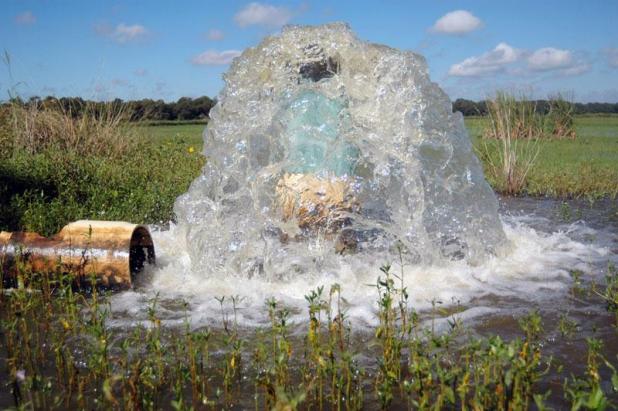
Photo by Bruce Schultz/LSU AgCenter
Water is pumped onto a rice field that will be used for crawfish. Mark
Shirley, an agent with the LSU AgCenter and Louisiana Sea Grant, recommends
crawfish producers wait for cooler temperatures before flooding their fields.
It’s almost time to flood crawfish ponds
It’s almost time to flood crawfish ponds and get started on another season, said Mark Shirley, aquaculture specialist with the LSU AgCenter and Louisiana Sea Grant. But he recommends that farmers wait a few more weeks when temperatures moderate a bit before beginning to flood.
“When the lows at night dip into the 60s and the highs are no longer in the 90s, then it’s time to raise the water level and get the brood stock out of the burrows to drop their young and populate the pond,” he said. “This usually happens in the first couple of weeks in October.”
Shirley added that “flood up” means putting a deep enough flood to saturate the levees to the height where the brood stock buried in at the end of last season. That may be 12, 14 or 16 inches of water across the pond.
If rice was planted solely for crawfish forage or if a farmer is dealing with a ratoon crop, the pond has probably been flooded with 2-4 inches of water since sometime in August.
“In general, a light flood like that does not stimulate any large numbers of crawfish to emerge from their burrows,” Shirley said.
Not until the levees get saturated, either from raising the water level or a big rain, do the crawfish dig out of their burrow and enter the pond.
The water quality and vegetation that the crawfish find when they emerge will determine their survival and growth, he said.
Warm water and lots of dead or dying vegetation will cause the dissolved oxygen to drop to near zero, and any crawfish that are not killed will be so severely stressed that their growth will be delayed and stunted. “This is especially true for the baby crawfish just released off the mother’s tail,” Shirley said.
He explained that management of a pond will determine if it has a healthy habitat for crawfish to survive and grow or if it has created a “dead zone.”
Most farmers realize this, but it is sometimes difficult to maintain good water quality, Shirley said. “It all depends on the amount of decaying vegetation in the water. Just a little rotting rice straw or dead weeds will rapidly consume all the oxygen, and all the pumping in the world cannot overcome the oxygen demand.”
Ponds planted with rice at the end of July or during August should have the best water quality and require almost no flushing unless a lot of weeds are present, he said. The rice plants should be 18 to 20 inches tall by early October and can tolerate a deeper flood at that time.
The worst habitat to try to manage for crawfish production is a natural vegetation pond, Shirley said. This could be ponds with varying amounts or combinations of cattail, cutgrass, pickerelweed, grasses, sedges, cocklebur, johnsongrass and everything else that grows on a moist soil. A pond with these conditions will require frequent flushing, which can be quite expensive.
For further information about crawfish farming, Shirley can be contacted at 337-898-4335 or by email at mshirley@agcenter.lsu.edu.
